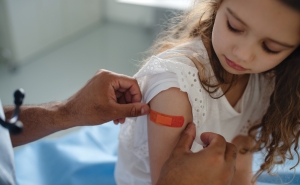Hidden Food Insecurity: The Adolescents Who Aren’t Getting Enough to Eat
Adolescents often miss out on the benefits of food programs that tend to target adults and younger kids.

In 2022, 17 million U.S. households faced food insecurity, meaning that they were unable to acquire sufficient food for everyone in the home. Several federal programs provide resources to bridge the gap, yet they often miss a key group: youth ages 14–18, who need more calories than younger kids.
In this Q&A, adapted from the March 6 episode of Public Health On Call, adolescent health researcher Kristin Mmari, DrPH, MA, talks about the long-term impacts being hungry can have on young people and why most programs aimed at relieving food insecurity don’t help this age group. Mmari, an associate professor in Population, Family and Reproductive Health, also rebuts false claims that nutrition assistance programs contribute to childhood obesity.
What exactly is food insecurity?
Food insecurity is when a person lacks access to nutritious food for normal growth and development. This may be caused by either unavailability of food or a lack of resources to obtain food.
There are different levels of food insecurity, from moderate to more severe food insecurity. When someone is severely food insecure, that means that they have maybe not eaten for the whole day. They’re hungry. But even those with moderate food insecurity may have to sacrifice some things to get food, and they may also not be getting the most nutritious foods. As you know, highly processed foods are usually cheaper.
How common is this in the US?
It’s very common in low-income households. It hasn’t been researched as much among adolescents compared to adults or children. Estimates are that it’s very high, but it’s also hidden. When I first looked into this about four or five years ago, it was largely unknown among adolescents.
But when we started interviewing adolescents in Baltimore, it was very common. In fact, just in our small sample, 53% were food insecure. And a third of those were severely food insecure. It’s something adolescents don’t like to discuss; many adolescents said that admitting that they’re hungry or food insecure is almost the worst thing that they can admit.
What age range do you use to define adolescence?
Adolescence is typically 10–19-year-olds, as defined by the World Health Organization. In our study, we looked at 14–18-year-olds. Other studies have looked at the full range, but we’ve found that among children that have food insecurity issues, the older an adolescent is, the more likely they are to be food insecure.
Why does food insecurity uniquely impact adolescents?
It hits adolescents differently because they’re in a critical period of development where they’re actively growing, their brains are expanding, their metabolic rates are increasing—all kinds of changes are happening to their bodies. And it’s at this moment when they have a need for more calories.
This isn’t often considered in terms of the whole food insecurity issue. When we talk about food assistance programs, we typically think of families with younger children. A lot of food pantries are geared to them. But we don’t associate adolescents with food insecurity.
There’s been some recent research linking food insecurity to a number of behavioral problems and problems with learning and academic achievement. If you can imagine adolescents in school who don’t have their caloric requirements met, you can imagine that their learning is going to be affected. A wide variety of other health outcomes are impacted as well.
Can you talk about some of those other health outcomes?
Some studies have linked adolescent food insecurity with cognitive issues, obesity, diabetes, and other outcomes like substance use and even sexual risk behaviors. For the study we did a few years ago, we conducted focus groups with adolescents. One of the things that was so heartbreaking to hear was that in all six of the Baltimore neighborhoods where we did these focus groups, girls described having to engage in transactional sex to get money to pay for food. It was very common.
Boys, meanwhile, would engage in basically “anything,” as they said. If you think of the “squeegee kids” [who wash windshields at intersections for money]—a lot of them mentioned doing that to get money for food. They said that was easier than going to places like food pantries, where they were often judged and people didn’t seem to want them there.
What about federal programs, like SNAP benefits? Why are adolescents falling through the gaps?
There are a number of reasons. For one, we have to look at how the SNAP [Supplemental Nutrition Assistance Program] benefits are calculated. SNAP benefits are tied to the USDA’s Thrifty Food Plan, which accounts for what would be a nutritious meal at a minimum price for four individuals in a family: a man and a woman, ages 20–60, a child ages 6–8, and another child ages 9–11. That calculation doesn’t include adolescents over that age who need more calories.
The other thing is that the benefits go to the head of the household. And in many low-income households, while adolescents aren’t called the head of the household, they are actually the ones responsible for many of the family's food needs. Many adolescents we spoke to were having to shop for food, yet they don’t have the benefits that come with SNAP debit cards. It’s rare that the household head gives them the cards to purchase food. They have the responsibility without these benefits, essentially.
You did this study of groups within Baltimore. Tell us a little bit more about what you found.
Just recently, during the COVID pandemic, we conducted a study to look at the impact of three different types of federal food assistance programs during the pandemic. We worked with the Mayor’s Office of Employment Development and Support Services in Baltimore City to recruit 284 adolescents.
In a nutshell, we found that for adolescents, there really was no association between these additional benefits offered during the pandemic and food insecurity.
In another part of the study, we asked adolescents themselves what they think they need to be able to deal with food insecurity. I think the most common answer was that they felt SNAP benefits need to increase. Many of the adolescents also felt that they should be given the benefits directly. We talked with policymakers, and they didn’t feel that that would go over well because we often think of adolescents as not being the most responsible. That’s the typical stereotype. But in fact, like I said before, these are adolescents who are often, in many ways, the most responsible in their households for getting food. So I think there is kind of that misconception out there.
I read that legislators across the U.S. are cutting these food programs. One of them cited childhood obesity as a reason to not give people access to programs that might help alleviate food insecurity. What do you have to say about that?
There is actually a link between food insecurity and obesity, and I think there needs to be more research to look at that. We all know that healthy food is much more expensive, especially in low-income neighborhoods. It’s no wonder that if the only choices are highly processed foods, there may be an obesity link. If anything, that exemplifies the problem even more.
What opportunities are there for solutions?
One of my colleagues, Kaitlyn Harper, has been working with young people in Baltimore on this issue and has implemented an online food pantry where adolescents can purchase foods. Another thing we’re thinking of trying is going through Instacart, where we can load up like a card, almost like a SNAP benefit card, and adolescents can choose and purchase foods that way. We’d like to do a study to see if adolescents purchase healthy food. What do they purchase? How often do they use it? And ultimately, does it reduce food insecurity?
But there’s more than that. The neighborhood where you live makes a big difference in terms of accessing food. I’m also really interested in community gardening and urban farming and the relationship of where those places are in relation to where adolescents live. There are a number of ideas to be examined. And young people are the ones who are the most informative because they know what works best for them, so we need to listen to them to learn which approaches work.
Lindsay Smith Rogers, MA, is the producer of the Public Health On Call podcast, an editor for Expert Insights, and the director of content strategy for the Johns Hopkins Bloomberg School of Public Health.





